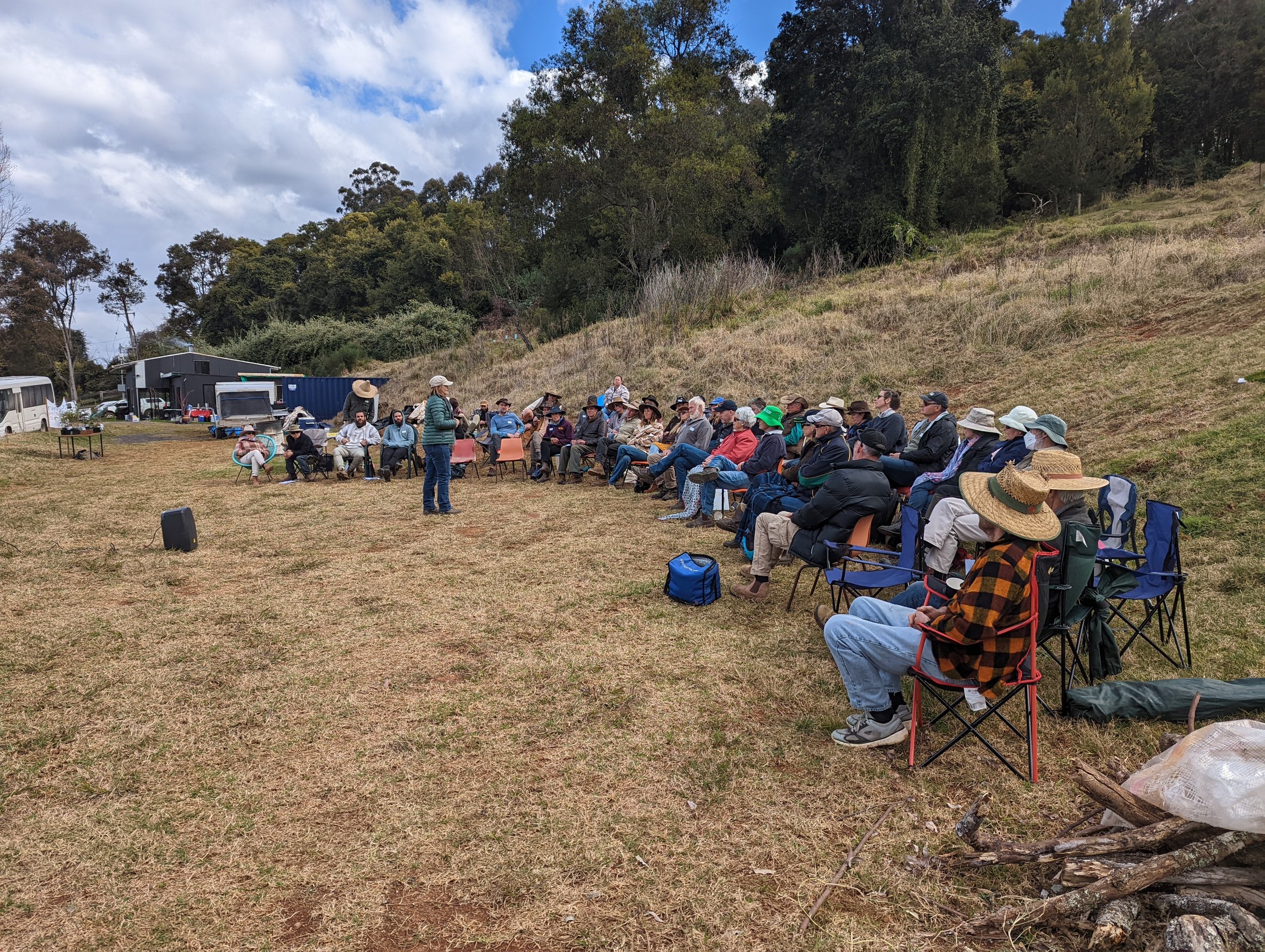An environmental farm seminar was held at Billys Creek NSW on Gumbaynggirr Country on the 7th of August 2022. The seminar was held at a farm named Lillys@Billys run be Dorothy and Robert Griffith. The big attendance by the local community at the seminar indicated a willingness to learn new tricks and network amongst like-minded people. The region is part of the Clarence watershed, hence any activities in this area effect a population of 155,000 people in Grafton and surrounding areas. This area supplies water to households from Yamba to Sawtell, south of Coffs Harbour, in Northern NSW Australia.
Evolvement Pty Ltd Environmental Farm Seminar at Lillys@Billys farm at Billys Creek
Below, I list the speakers that shared their experiences.
Justin Williams came to discuss his experience and successes on his farm with grant money provided. He lives on the Nymboida River at Bostobrick and raises cattle. In the river he has Eastern Freshwater Cod, it is rare and classified Endangered. Grant money (around $65,000) he has received has gone into riparian restoration, removal of weeds and provision of water for his cattle away from the river. A sanctuary along his river has been formed for wildlife and the cod. Justin explained how receiving one grant led to more grants as a trust developed in his stewardship. It has not detrimentally affected his farm, only improved productivity and the river.
Mark Graham is the local expert on all things fauna and flora. For the past few months he has been undertaking a detailed environmental plan on the upper regions of the Nymboida/Blicks river system. Mark discussed how restoring the local creeks can provide a sponge to retain water on the farm, whilst reducing erosion runoff and flooding further downstream. Solutions to Bellbird Miner associated dieback of the trees across the region were flagged by Mark and local nursery/restoration specialist Barry Hicks. Bellbirds an aggressive bird, cause tree dieback in the local Sydney Blue gums. They do this by eliminating smaller birds that remove lerp insect attack, to the trees. Mark and Barry explained that removal of vines can reduce the breeding refuge for Bell Birds. Replanting understorey shrubs and removal of invasive privet allows the smaller birds to re-populate the trees. Mark told us about the many species of truffles that inhabit the soil around our rainforest and the animal species that benefit from these, namely the Potaro and Bandicoot. Perhaps more divisive advise (for farmers) was provided about Dingoes, and how important they are as a apex predator in the landscape.
A glorious lunch was provided by the Tyringham Rural Fire Service. Sponsored by Clarence Landcare.
Local nurseryman Barry Hicks from Blue Rock Nursery provided a range of provenance species and gave advise on planting to restore biodiversity.
Lillys@Billys Farm with Barry Hicks’s beautiful range of Rainforest plants.
Deanna Fernance, from Clarence Landcare, who sponsored lunch for the event. Deanna let all know about the support individuals and groups that are volunteering their time toward NRM on private and public lands.
Simone Garwood from the NSW Biodiversity Conservation Trust (BCT), discussed the wide variety of grants available for farm restoration available from different organisations Australia and NSW, starting with Land for Wildlife administered by Landcare and the various options from BCT.
Toby Grogan is a consultant with ImpactAg, an organisation that specialises in Regenerative Farming and Carbon farming and improving farms. Toby explained how his companies work improves carbon soil sequestration on large properties in Australia and overseas.
Andrew Ward (Wardy) is from Regen Farmers Mutual RFM (https://regenfarmersmutual.com/). Wardy gave us a rundown on how RFM is a mutual or co-operative for farmers. It provides a unique system of software that provides mapping for farmers to manage their farms and environmental assets. The software is called Digital Twin, it provides a snapshot of your farms current environmental condition. It allows a farmer to plan his farm for carbon and ecological improvements. A farmer can test various scenarios to achieve Net Zero to apply for grants, loans and market his/her products. RFM is working with Clarence Council to determine how best it can assist local farmers.
Lillys@Billys farm walk
On a farm walk we examined problems and discussed solutions to Bell Bird Miner Associated Dieback, erorsion and weed control and novel crops being intoduced at Lillys@Billys.
Robert Griffith, owner of Lillys@Billys and a Landscape Agronomist discussed how he assists farmers with the Digital Twin software from Regen Farmers Mutual. Robert is a landscape designer and ecologist and can provide farmers with long term advise, he has the backing of 20 more landscape agronomists with expertise in all forms of farming as a consultant with RFM.
All up, the day was attended by over 50 people, and provided farmers and rural land-owners with options to improve their soil, and their ecological environment. The next step is to facilitate worklife balance for properties in terms options to provide sustainable products in an ecological framework.
Robert Griffith BEnvSc Hort
0468 787 071 rob@greenlook.com.au



